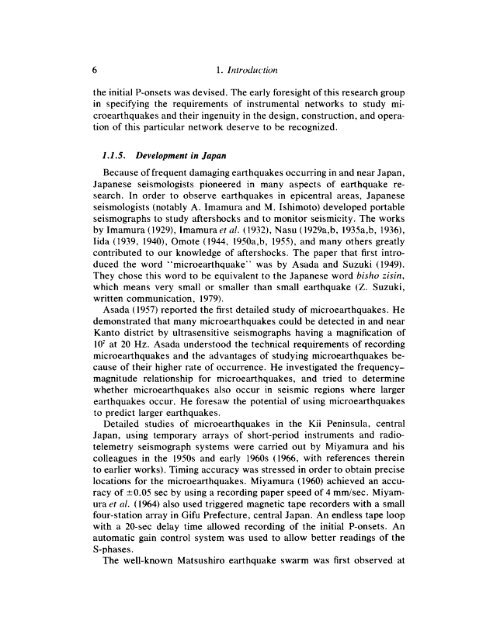principles and applications of microearthquake networks
principles and applications of microearthquake networks
principles and applications of microearthquake networks
You also want an ePaper? Increase the reach of your titles
YUMPU automatically turns print PDFs into web optimized ePapers that Google loves.
6 1. Introduction<br />
the initial P-onsets was devised. The early foresight <strong>of</strong> this research group<br />
in specifying the requirements <strong>of</strong> instrumental <strong>networks</strong> to study <strong>microearthquake</strong>s<br />
<strong>and</strong> their ingenuity in the design, construction, <strong>and</strong> operation<br />
<strong>of</strong> this particular network deserve to be recognized.<br />
1.1.5. Development in Japan<br />
Because <strong>of</strong> frequent damaging earthquakes occurring in <strong>and</strong> near Japan,<br />
Japanese seismologists pioneered in many aspects <strong>of</strong> earthquake research.<br />
In order to observe earthquakes in epicentral areas, Japanese<br />
seismologists (notably A. Imamura <strong>and</strong> M. Ishimoto) developed portable<br />
seismographs to study aftershocks <strong>and</strong> to monitor seismicity. The works<br />
by Imamura (1929), Imamura et a!. (1932), Nasu (1929a,b, 1935a,b, 1936),<br />
Iida (1939, 1940), Omote (1944, 1950a,b, 1955), <strong>and</strong> many others greatly<br />
contributed to our knowledge <strong>of</strong> aftershocks. The paper that first introduced<br />
the word “<strong>microearthquake</strong>” was by Asada <strong>and</strong> Suzuki (1949).<br />
They chose this word to be equivalent to the Japanese word bisho zisin,<br />
which means very small or smaller than small earthquake (Z. Suzuki,<br />
written communication, 1979).<br />
Asada (1957) reported the first detailed study <strong>of</strong> <strong>microearthquake</strong>s. He<br />
demonstrated that many <strong>microearthquake</strong>s could be detected in <strong>and</strong> near<br />
Kanto district by ultrasensitive seismographs having a magnification <strong>of</strong><br />
10‘ at 20 Hz. Asada understood the technical requirements <strong>of</strong> recording<br />
<strong>microearthquake</strong>s <strong>and</strong> the advantages <strong>of</strong> studying <strong>microearthquake</strong>s because<br />
<strong>of</strong> their higher rate <strong>of</strong> occurrence. He investigated the frequencymagnitude<br />
relationship for <strong>microearthquake</strong>s, <strong>and</strong> tried to determine<br />
whether <strong>microearthquake</strong>s also occur in seismic regions where larger<br />
earthquakes occur. He foresaw the potential <strong>of</strong> using <strong>microearthquake</strong>s<br />
to predict larger earthquakes.<br />
Detailed studies <strong>of</strong> <strong>microearthquake</strong>s in the Kii Peninsula, central<br />
Japan, using temporary arrays <strong>of</strong> short-period instruments <strong>and</strong> radiotelemetry<br />
seismograph systems were carried out by Miyamura <strong>and</strong> his<br />
colleagues in the 1950s <strong>and</strong> early 1960s (1966, with references therein<br />
to earlier works). Timing accuracy was stressed in order to obtain precise<br />
locations for the <strong>microearthquake</strong>s. Miyamura (1960) achieved an accuracy<br />
<strong>of</strong> k0.05 sec by using a recording paper speed <strong>of</strong> 4 mdsec. Miyamura<br />
et al. (1964) also used triggered magnetic tape recorders with a small<br />
four-station array in Gifu Prefecture, central Japan. An endless tape loop<br />
with a 20-sec delay time allowed recording <strong>of</strong> the initial P-onsets. An<br />
automatic gain control system was used to allow better readings <strong>of</strong> the<br />
S-phases.<br />
The well-known Matsushiro earthquake swarm was first observed at






